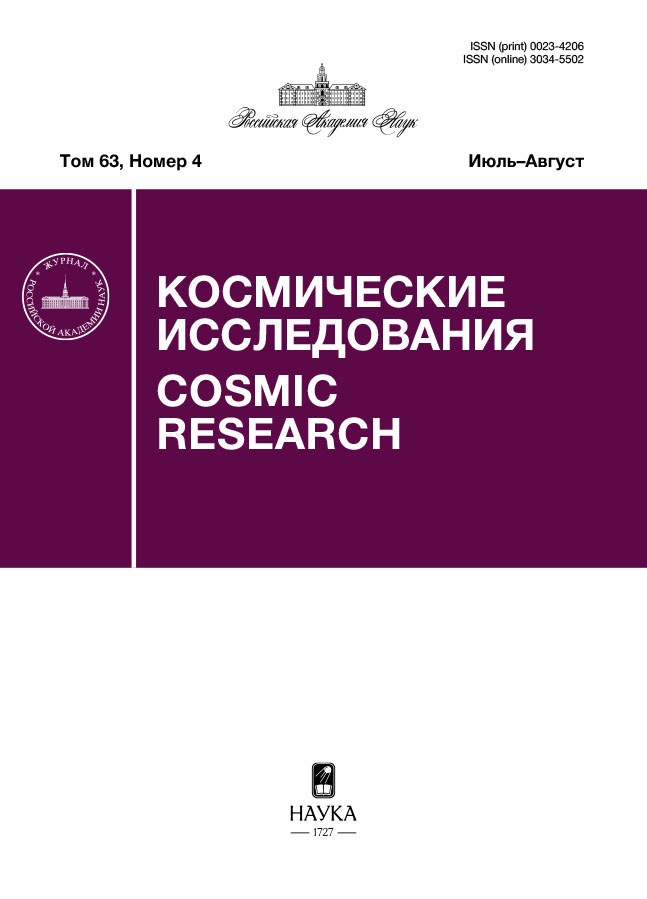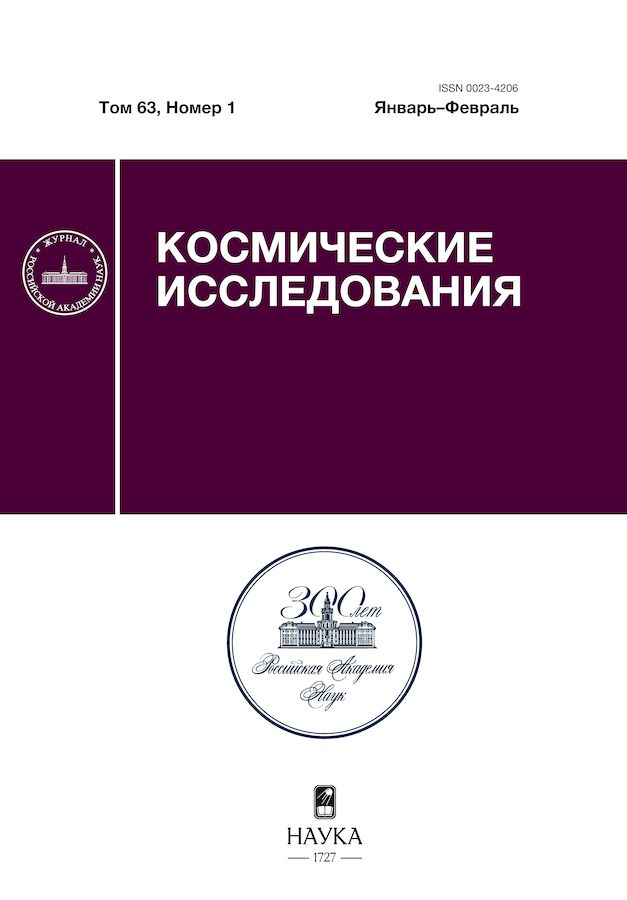Vector graphs, phase trajectories and portraits of the magnetic field and velocities of solar plasma particles in the phase space of the heliosphere
- Authors: Antonov Y.A.1, Zakharov V.I.1,2,3, Myagkova I.N.1, Suhareva N.A.1, Shugai Y.S.1
-
Affiliations:
- Lomonosov Moscow State University
- Institute of Atmospheric Physics named after A.M. Obukhov RAS
- Schmidt Institute of Physics of the Earth of the Russian Academy of Sciences
- Issue: Vol 63, No 1 (2025)
- Pages: 23–37
- Section: Articles
- URL: https://rjsocmed.com/0023-4206/article/view/682923
- DOI: https://doi.org/10.31857/S0023420625010038
- EDN: https://elibrary.ru/HETVZA
- ID: 682923
Cite item
Abstract
The material presented in the paper continues a series of studies on the development of the use of the vector graph method for analyzing the characteristics of complex field and plasma structures generated by the Sun in interplanetary space. With a simplified approach to describing such systems using statistical methods, the collective processes of plasma and field interactions may remain undetected, in particular, complex multicomponent structures in the spatiotemporal distribution functions may be missed. The main problem of statistical methods is the neglect of the order of the states of the system being studied and the loss of information contained in this order. Based on the data blocks obtained by the detectors of the WIND apparatus in the CWE research complex and provided by the Coordinated Data Analyzes Web database, implementations of graphs for magnetic field induction vectors and solar wind particle velocity vectors reconstructed on the basis of experimental samples are discussed. The regimes of magnetic storms, the formation of magnetic clouds, and events associated with coronal mass ejections, both ICME and CME, are considered. The presented new method of synchronized pairs of graphs allows us to move from a phenomenological description of the process to a classification of the types of observed and studied multi-processes based on the structural implementations of graphs.
Full Text
About the authors
Yu. A. Antonov
Lomonosov Moscow State University
Email: suhareva@phys.msu.ru
Russian Federation, Moscow
V. I. Zakharov
Lomonosov Moscow State University; Institute of Atmospheric Physics named after A.M. Obukhov RAS; Schmidt Institute of Physics of the Earth of the Russian Academy of Sciences
Email: suhareva@phys.msu.ru
Russian Federation, Moscow; Moscow; Moscow
I. N. Myagkova
Lomonosov Moscow State University
Email: suhareva@phys.msu.ru
Skobeltsyn Institute of Nuclear Physics Lomonosov Moscow State University
Russian Federation, MoscowN. A. Suhareva
Lomonosov Moscow State University
Author for correspondence.
Email: suhareva@phys.msu.ru
Skobeltsyn Institute of Nuclear Physics Lomonosov Moscow State University
Russian Federation, MoscowYu. S. Shugai
Lomonosov Moscow State University
Email: suhareva@phys.msu.ru
Skobeltsyn Institute of Nuclear Physics Lomonosov Moscow State University
Russian Federation, MoscowReferences
- Maiewski E.V., Malova H.V., Popov V.Y., Zelenyi L.M. Ulysses flyby in theheliosphere: Comparison of the solar wind model with observational data // Universe. 2022. V. 8(6). Art.ID. 324. https://doi.org/10.3390/universe8060324
- Koomen M., Detwiler C., Brueckner G. et al. White lightcoronagraph in OSO-7 // Applied Optics. 1975. V. 14(3). P. 743–751.
- Chikunova G., Dissauer K., Podladchikova T. et al. Coronal dimmings associated with coronal mass ejections on the solar limb // Astrophysical J. 2020. V. 896(1). Art.ID. 17. https://doi.org/10.3847/1538-4357/ab9105
- Wilson L.B. III, Brosius A.L., Gopalswamy N. et al. A quarter century of wind spacecraft discoveries // Reviews of Geophysics. 2021. V. 59(2). Art.ID. e2020RG000714. https://doi.org/10.1029/2020RG000714
- Wilson L.B. III. Wind 2020 senior review proposal. https://wind.nasa.gov/docs/Wind_SR2020_proposal.pdf
- Lepping R., Acũna M., Burlaga L. et al. The wind magnetic field investigation // Space Science Reviews. 1995. 71. P. 207–229.
- Adhikari L., Khabarova O., Zank G.P. et al. The role of magnetic reconnection–associated processes in local particle acceleration in the solar wind // Astrophysical J. 2019. V. 873(1). Art.ID. 72. https://doi.org/10.3847/1538-4357/ab05c6
- Bale S., Badman S., Bonnell J. et al. Highly structured slow solar wind emerging from an equatorial coronal hole // Nature. 2019. V. 576(7786). P. 237–242. https://doi.org/10.1038/s41586-019-1818-7
- Alberti T., Consolini G., Carbone V. et al. Multifractal and chaotic properties of solar wind at MHD and kinetic domains: An empirical mode decomposition approach // Entropy. 2019. V.21(3). Art.ID. 320. https://doi.org/10.3390/e21030320
- Prasad P.K., Gowrisankar A., Saha A. et al. Dynamical properties and fractal patterns of nonlinear waves in solar wind plasma // Physica Scripta. 2020. V. 95(6). Art.ID. 065603. https://doi.org/10.1088/1402-4896/ab833c
- Godsil C., Royle G.F. Algebraic graph theory. Part of the book series: Graduate Texts in Mathematics. V. 207. Springer Science & Business Media, 2001.
- Kalofolias V. How to learn a graph from smooth signals // Artificial intelligence and statistics. P. 920–929. PMLR, 2016.
- Pal M., Samanta S., Ghorai G. Modern trends in fuzzy graph theory. Springer, 2020.
- Cheng S.-W., Cheong O., Lee T. et al. Fitting a graph to one-dimensional data // Theoretical Computer Science. 2021. Iss. 867. P. 40–49.
- Daitch S.I., Kelner J.A., Spielman D.A. Fitting a graph to vector data // Proc. 26th Annual International Conference on Machine Learning. Montreal, Canada. 2009. P. 201–208.
- Shugay Y., Slemzin V., Veselovsky I. Magnetic field sector structure and origins of solar wind streams in 2012 // J. Space Weather and Space Climate. 2014. V. 4. Art.ID. A24.
- Antonov Y., Zakharov V., Myagkova I. et al. Structure and dynamics for graphs of interplanetary magnetic field vectors // Cosmic Research. 2024. V. 62(2). P. 147–161. https://doi.org/10.1134/S0010952523600336
- Kilpua E., Isavnin A., Vourlidas A. et al. On the relationship between interplanetary coronal mass ejections and magnetic clouds // Annales Geophysicae. 2013. V. 31(7). P. 1251–1265.
- Shaikh Z.I., Raghav A.N. Statistical plasma properties of the planar and nonplanar ICME magnetic clouds during solar cycles 23 and 24 // Astrophysical J. 2022. V. 938(2). Art.ID. 146. https://doi.org/10.3847/1538-4357/ac8f2b
- Wu C.-C., Gopalswamy N., Lepping R.P. et al. Characteristics of magnetic clouds and interplanetary coronal mass ejections which cause intense geomagnetic storms // Terrestrial, Atmospheric & Oceanic Sciences. 2013. V. 24(2).
- Ghag K., Sathe B., Raghav A. et al. Statistical study of geo-effectiveness of planar magnetic structures evolved within ICME’s // Universe. 2023. V. 9(8). Art.ID. 350. https://doi.org/10.3390/universe9080350
- Thalmann J., Dumboviс M., Dissauer K. et al. Tracking magnetic flux and helicity from the Sun to Earth: Multi-spacecraft analysis of a magnetic cloud and its solar source // Astronomy & Astrophysics. 2023. V. 669. Art.ID. A72. https://doi.org/10.1051/0004-6361/202244248
- Manchester W. IV, Kozyra J., Lepri S. et al. Simulation of magnetic cloud erosion during propagation // J. Geophysical Research: Space Physics. 2014. V. 119(7). P. 5449–5464.
- Li L., Chen T., Shen C. et al. Near-surface atmospheric electric field changes through magnetic clouds via coronal mass ejections // Geoscience Letters. 2023. V. 10(1). Art.ID. 45. https://doi.org/10.1186/s40562-023-00299-2
- Cane H., Richardson I. Interplanetary coronal mass ejections in the near-earth solar wind during 1996–2002 // J. Geophysical Research: Space Physics. 2003. V. 108(A4).
- Richardson I.G., Cane H.V. Near-earth interplanetary coronal mass ejections during solar cycle 23 (1996–2009): Catalog and summary of properties // Solar Physics. 2010. Iss. 264. P. 189–237.
- Antonov J.A., Tsyganov M.V., Suhareva N.A. Topological properties of satellite monitoring time series for the interplanetary magnetic field // 29th International Symposium on Atmospheric and Ocean Optics: Atmospheric Physics. Moscow, Russia. 2023. V. 12780. P. 1491–1497. https://doi.org/10.1117/12.2690853
- Landau L.D., Lifshits E.M. Mechanics. V. 1. CUP Archive, 1960.
- McConnell A.J. Applications of tensor analysis. Courier Corporation, 2014.
- Goodman J.W. Statistical optics. John Wiley & Sons, 2015.
- Xie C., Zhong W., Mueller K. A visual analytics approach for categorical joint distribution reconstruction from marginal projections // IEEE Transactions on Visualization and Computer Graphics. 2016. V. 23(1). P. 51–60.
- Sadovnikov B., Inozemtseva N., Perepelkin E. Generalized phase space and conservative systems // Doklady Mathematics. 2013. V. 88. P. 457–459.
- Perepelkin E.E., Sadovnikov B.I., Inozemtseva N.G. et al. Universal density matrix for the phase space // arXiv preprint. 2019. https://doi.org/10.48550/arXiv.1904.04950
- Perepelkin E.E., Sadovnikov B.I., Inozemtseva N.G. et al. Exact time-dependent solution of the Schroedinger equation, its generalization to the phase space and relation to the gibbs distribution // Physica Scripta. 2022. V. 98(1). Art.ID. 015221.
- Perepelkin E.E., Sadovnikov B.I., Inozemtseva N.G. et al. Dispersion chain of quantum mechanics equations // J. Physics A: Mathematical and Theoretical. 2023. V. 56(14). Art.ID. 145202. https://doi.org/10.1088/1751-8121/acbd71
Supplementary files



















